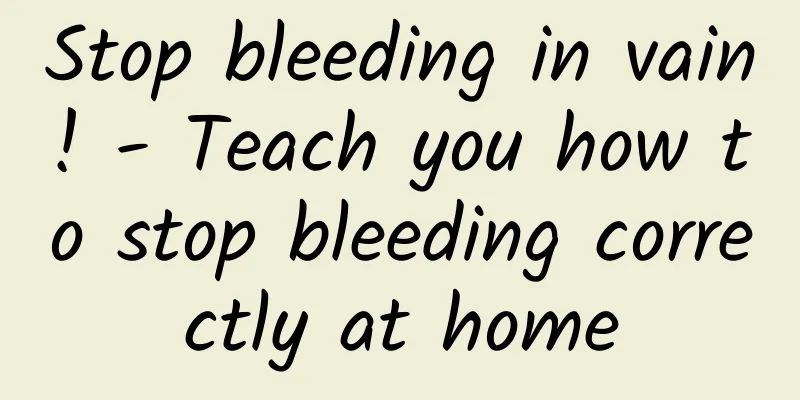Stop bleeding in vain! - Teach you how to stop bleeding correctly at home

|
Author: Han Liqiang, deputy chief physician of Tianjin Third Central Hospital Reviewer: Guo Shuzhang, Chief Physician, Tianjin Third Central Hospital In daily life, bumps and bruises are inevitable. Sometimes the body may be accidentally scratched by a knife, glass or broken porcelain, causing bleeding. This is also common. So, how should we deal with bleeding at home after trauma? Should we use cloth strips, ropes or belts to stop bleeding, as shown in some movies and TV shows? Is this method advisable in real life? Let's take a look at the following real case. One night, a young man in his 20s came to the emergency room in a hurry, accompanied by his family. The young man held his left arm with his right hand, with a painful expression on his face. There was a plastic bag on his left arm, which was full of blood. His clothes were also splattered with blood. The doctor on duty in the emergency department hurriedly checked the young man's wound and asked his family about the process of injury. The doctor estimated that there was about 200 ml of blood in the plastic bag. After removing the plastic bag, he found that the boy's upper arm was wrapped with waste wires. The wound was on the back of his left hand and was about 5 cm long. Although it was wrapped with waste wires, the wound was still like a small fountain, still gushing out blood. Figure 1 Copyright image, no permission to reprint The young man was accompanied by his father. The father and son had a quarrel over trivial family matters while having dinner together. In anger, the young man punched the glass coffee table at home, which broke into pieces. The broken glass cut a long cut on the back of his hand, and blood immediately oozed out. The young man's father saw that the bleeding was quite "violent" and thought that the artery must be broken, so he quickly used the remaining wires from the home renovation to tie up the young man's arm and rushed the young man to the emergency department of the hospital. It took 30 minutes from the time the young man was injured to the time the doctor checked the wound. The doctor on duty told the young man's father to untie the wires. "Why? The bleeding is so severe, it must be an artery that has been broken! Wouldn't it bleed more after untying it?" The young man's father was skeptical. After untying the wires, he was surprised to find that the amount of blood sprayed from the wound on the back of his hand was significantly less. After the doctor pressed it with gauze for a few minutes, the bleeding basically stopped. Next, the doctor performed debridement and suture on the young man. Fortunately, only the vein was broken, and the tendon was not damaged. He was fine after the wound was sutured. After reading this case, you may be confused. If the wound is so long and bleeding, shouldn't it be tied up with a rope or something else? Why does it bleed more when it is tied up? In fact, many people only have a superficial understanding of medical knowledge and do not know what "excessive bleeding" means. They think that excessive bleeding after an injury means that the artery is broken and the consequences will be serious if it is not dealt with quickly. In addition, many people think that the most effective way to stop bleeding is to quickly plug the wound with something. Some people also use various folk remedies, such as flour, dust, and even cigarette ash, to sprinkle on the wound. Little do they know that this is unscientific and will not only increase the difficulty of cleaning the wound, but also increase the probability of wound infection. Figure 2 Copyright image, no permission to reprint In medicine, commonly used emergency hemostasis methods include finger pressure hemostasis, pressure bandage and tourniquet hemostasis . After being injured and bleeding, people will subconsciously press the wound with their fingers. This is the finger pressure hemostasis method . This method is a short-term emergency measure and is the most effective method for smaller wounds, but the pressure time cannot be too long. For larger wounds on the limbs or wounds with more soft tissue defects, the effect of relying solely on finger pressure is not very good, and once the finger pressure is used, it is difficult to let go. At this time, the method of using fingers to press the adjacent artery can be used to achieve the purpose of hemostasis. This is the same principle as the tourniquet. This method can be used for general small artery and venous injury bleeding. Of course, if you don’t know where the adjacent artery is, it is difficult to achieve the ideal hemostasis effect. Figure 3 Copyright image, no permission to reprint The pressure bandage method is to first put sterilized gauze or dressing on the wound, press the outer layer with gauze pad, and then use a bandage to apply pressure. After bandaging, raise the affected limb to increase venous return and reduce bleeding. This is the most effective way to stop bleeding in daily life, and it is convenient for doctors to deal with wounds. If there is no sterile gauze or something like that at home, you can temporarily use a relatively clean towel to compress and bandage the wound. Even for larger wounds, the effect is very good. For common ruptures of the ulnar artery and radial artery in the wrist, the pressure bandage method can have a good hemostatic effect. Figure 4 Copyright image, no permission to reprint The tourniquet method is suitable for severe bleeding in the limbs. The commonly used tourniquet is a rubber tube about 1 meter long. If there is no tourniquet, it can be replaced with a cloth strip or bandage in an emergency. Tie the tourniquet to the base of the affected limb, such as the upper 1/3 of the upper arm, the upper 1/3 of the thigh, etc. Figure 5 Copyright image, no permission to reprint Tourniquet hemostasis is a commonly used method in clinical surgery. The main purpose is to stop bleeding and allow doctors to obtain a clear surgical field of view. However, it should be noted that there are clear requirements for the binding strength of the tourniquet: the tourniquet pressure for adults' upper limbs should not exceed 300 mmHg, and the lower limbs should not exceed 500 mmHg. For children, the strength can be halved. If you want to achieve the ideal hemostasis effect, you need to close the artery pressure. This strength is very uncomfortable for awake patients. After only about 10 minutes of compression, you will obviously feel the pain and discomfort of the limbs. It will be more unbearable if the time is longer. However, if the pressure does not reach the state of arterial pressure closure, it only closes the vein, the return blood flow will be blocked, and the artery will continue to pump blood, which causes blood to spurt out from the ruptured vein, forming "fountain-like bleeding" and creating the illusion of arterial rupture. The young man in this case belongs to this situation. In daily life, if you have not received medical training, it is often difficult to achieve effective pressure when using a tourniquet to stop bleeding, which may lead to worsening bleeding. Therefore, it is not recommended to use this method on your own . For the young man in this case, the correct way to stop bleeding is to use a pressure bandage . You may also be wondering: How to tell whether it is an artery injury or a vein injury? Veins are superficial, less elastic, and the color of venous blood is darker, so the probability of rupture is higher; while arteries are deeper, more elastic, and the color of arterial blood is bright red, and there may be spurting bleeding when they rupture. The most important factor in promoting wound healing is the absence of infection. The main causes of infection are the time of injury, the degree of wound contamination, the degree of surgical debridement, etc. The probability of wound infection increases with the extension of injury time. Clinically, it is generally based on 8 hours. In other words, starting from the moment of injury, the sooner the debridement and suture are performed, the better. It is best not to exceed 8 hours . In special circumstances, it can be extended to 12 hours. When trauma occurs, the doctor's job is to clean and suture the wound, but the wound is basically contaminated, so the patient should pay attention to minimizing the degree of wound contamination and avoid using various materials to fill the wound . Pressure bandage is the most commonly used and effective method of stopping bleeding in daily life. After traumatic bleeding, if the bleeding is not in the form of spray and the wound is dirty, you can simply rinse the wound with tap water at home. It is recommended to prepare disinfectant at home in advance (the most commonly used one is iodine tincture, because it does not contain alcohol and the pain will be significantly reduced when used). You can simply disinfect the wound with disinfectant, press a relatively clean towel on the wound, then apply pressure and hold the wound with your hands or fingers, and go to the hospital immediately. Do you understand? Improper use of hemostatic items such as ropes will increase bleeding. Only by properly stopping bleeding can you get a better prognosis. |
>>: 10 questions and 10 answers to help you understand astigmatism
Recommend
How many months of pregnancy does the heart beat?
After a pregnant woman becomes pregnant, she must...
What is the self-test method for female sexual frigidity?
Making love is a matter between two people. If on...
Height and weight standard for women
In today's society where thinness is consider...
What medicine should women take for urethral pain
Many women are affected by gynecological diseases...
How to eat yacon better? The nutritional value of yacon
Yacon tastes like pears and is loved by people be...
40 days pregnant, stomach pain but no bleeding
If you have abdominal pain for 40 days during pre...
Kidney Disease Popular Science | What terrible complications does nephrotic syndrome bring?
Xiao Wu, who was only 28 years old, went to the l...
Popular Science on the Past and Present of Cervical Cancer
The past and present of cervical cancer Li Jiangn...
How to make magnolia tea? What are the effects and functions of magnolia tea?
Magnolia tea is made of high-quality Wuzhishan sp...
What is the difference between an air conditioning fan and an air conditioner? How to use an air conditioning fan ice crystal box
In recent years, the refrigeration appliances on ...
Do you think eating bananas can relieve constipation? This statement is not reliable!
In recent years, the claim that eating bananas ca...
Seven Yes and No to Stay Away from Gynecological Diseases
There are many tips in life that can prevent and ...
What to do if there is inflammation in the lower body
Female friends are very scared when they hear abo...
How many days does medical abortion last?
There are many common problems for women after ha...
Caesarean section uterine incision location diagram
Cesarean section is a cesarean section. Many wome...

![[Doctors Talk] Common fever diseases in children: identification, treatment and care](/upload/images/67f17a15ea5a8.webp)







